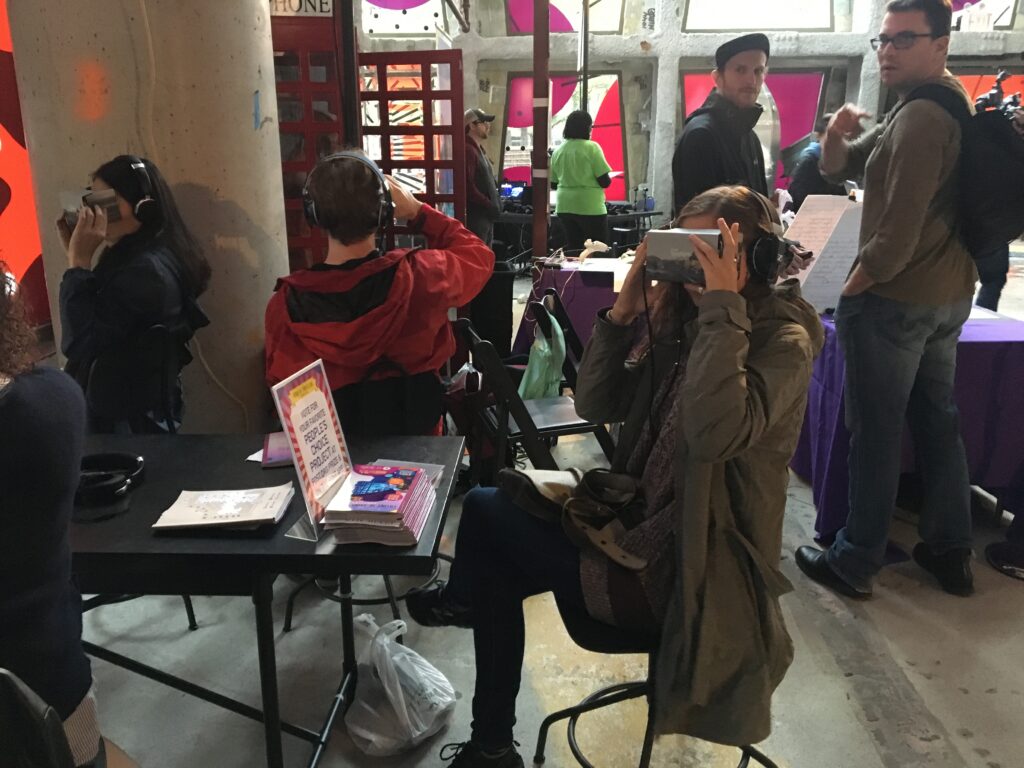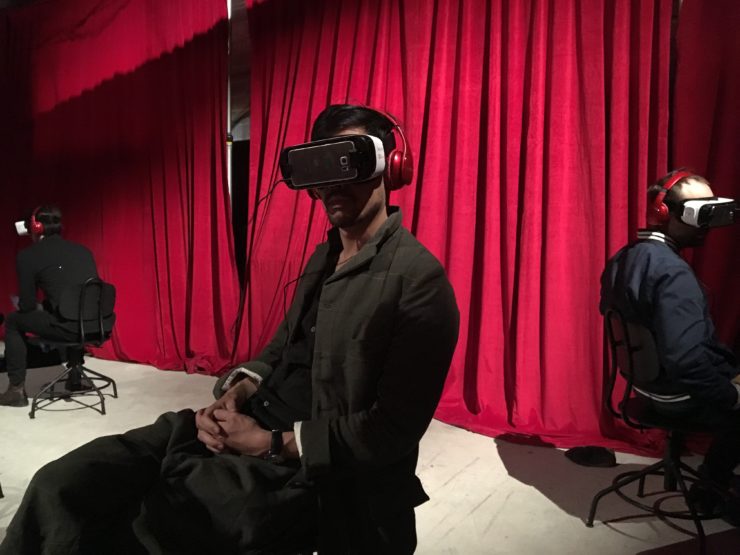In a gutted museum in East Harlem last weekend, I plunged into arctic waters, went on an African safari, flew like a bird and even experienced the last few minutes of a celebrity’s life.
New Yorkers are notorious for living in their own little worlds, but for the virtual-reality Future of Storytelling Festival, we all used the same blocks to build an individual story within the larger narrative.
For the past five years, the Future of Storytelling gathering has been the go-to place for geeks in the city. This year, organizers opened FoST Fest to the public, with 40 interactive exhibits and 16 panel discussions.
My first stop was to Famous Deaths, where I signed up to die like the late music icon Whitney Houston. When it was my turn to be placed into something I called the mortuary chest, I have to admit I was morbidly excited.
For the next four minutes, my imagination transported me to a bathtub. (Because we all know what a bathtub looks and feels like, we didn’t need VR goggles.) Although it was so dark that I couldn’t see my hand, I closed my eyes and tried to imagine myself as Whitney in 2012. I could hear her famous voice singing to herself, crying and pouring a glass. It felt like the audio was inside me, like it was meant to be my voice. I could hear water splashing, and my nose was assaulted by the smell of what I thought was a citrus candle. I was later told that they sprayed her perfume, Petite Cherie, which has fruity undertones.
The audio played as different scents were timed and injected in small doses into the canister while I was inside: olive oil, weed, fast food and crack. (Happy to report that I have no idea what crack smells like, so I couldn’t tell with that one.)
I felt a moment of pure dread when it all suddenly went silent and I couldn’t smell anything. I contemplated pressing the panic button they placed at my chest, when they opened up the door and brought me back to the light. My thought as I was wheeling out was “She must have been so lonely during her last moments. I need to get out of here.”
It was an intimate and vulnerable experience. They say that scent is one of the strongest ties to memory, and I believe it. Now, whenever I smell a citrus-scented bubble bath, I’ll become Whitney.

Next, I went to Riot. I was instructed to stand on a marked circle on the ground as I faced a large TV screen with a simple webcam attached at the top. An immersive video installation inspired by the Ferguson unrest and Black Lives Matter, it uses sophisticated facial technology and neuro-gaming software to detect your distress.
Depending on how your face reacts to scenes of rebellious city teenagers escaping the police in Britain, you will either have a two-minute experience or one that lasts up to eight minutes. If you get upset or angry, for example, when they arrest the woman in the video, your experience will be shorter. Perhaps that's because they had achieved their purpose: It was meant to move you. For those who don't get upset in the first few minutes, the creators' goal seems to be finding out how far they can go before even the calmest person reacts to the perceived injustice on the screen. Because I maintained a level of calmness, I lasted until the final level.
“The idea is looking into the natural response; it is more meaningful because you feel it,” Mark Atkin, one of the creators of the Riot experience, told me.
“Theater is well over 2,000 years old, and it won’t likely change,” he said. “But what interests me and the director, Karen Palmer, is to enhance storytelling. Screens are going to disappear and the internet is going to be embedded into objects around us. It is a different form of storytelling, with wearable technology.”
I realized that the future of virtual-reality storytelling is not in just traveling through exotic or sci-fi locations to forget, but in being present in the reality of today so you could remember. Instead of merely receiving words, audio or visuals, each user is a co-pilot or co-author. We are not just a fly on the wall, but a participant.
At another exhibit at the festival, Flock, users became part of a flock of birds. Sebastian Herscher, part of the team behind Flock, talked about the project.
“What we try to achieve in this shared space is mixed reality. It is a liquid, social experience that is gamified with an individual story arc. We had about 700 people participate over the weekend. We chose birds to get them to move in a group as a social unit, rather than an individual,” Herscher said.
For this one, we were taken to the fourth floor, and had a single white wing strapped on each arm. We were placed into a small room with dark curtains on all sides, and told to make bird-like noises and have fun. We were brought in just a few at a time, with headphones and VR goggles, and were encouraged to be one with the bird. We listened to assigned music as we flapped our wings and became giddy.
“When you wear a costume, the world is different. We facilitate the experience,” the creator of Flock, David Lobser, told me when I asked why we they gave us wings. Lobser has taught animation at Harvard University and is the senior artist in residence at NYU’s Media Research Lab.
"Screens are going to disappear and the internet is going to be embedded into objects around us. It is a different form of storytelling, with wearable technology.”
But not all of the displays made us depend on a device. Sometimes, a piece of paper and imagination could take you to another world.
“The ego is missing in puppeteering,” Rowan Magee told me as I carved out the heart from a pink gingerbread puppet made out of paper that I had been given. (I thought it would look more interesting as a silhouette with the missing heart shining under the spotlight.) His puppeteering partner, Admiral Grey, a multidisciplinary artist, used the old-fashioned cutouts, a hand-held spotlight and shadows to transform the space into a makeshift puppet show. They were a reminder that not all invented reality had to be high tech.
As I left the event space under a cloudy but very real sky, I was reminded of the FoST tagline: “All the World’s A Stage. Come Be a Player.” Yes, we can strap on fancy goggles and be part of a multi-sensory storytelling adventure. We can be anyone we choose to be and be virtually anywhere. But there are stories all around us in the real world, too. The future of storytelling isn’t in one or the other, but in both.



